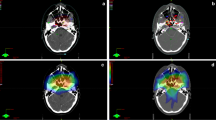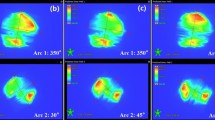Abstract
Purpose
This is a radiation field simulation study using CT images designed to see the cochlear dosimetry and its correlation with tumour and treatment characteristics during radiotherapy for head and neck cancers (HNC) for identifying the factors associated with a higher dose delivered to the cochlea.
Methods
From 2018 to 2020, 80 patients with HNC underwent volumetric arc therapy (VMAT) to a dose of 66–70 Gy at 2 Gy per fraction with bilateral cochlea contoured for VMAT optimization as an organ at risk. Minimum, mean and maximum planned radiation dose to the cochlea based on tumour and treatment characteristics and dose-volume histogram variables of VMAT plans were analysed.
Results
Mean (standard deviation, SD) cochlear volume was 0.14 (0.06) cm3 with maximum and mean planned doses of 10.3 (SD = 11.6) Gy and 8.5 (SD = 9.8) Gy, respectively. We found a statistically significant correlation between mean dose received by bilateral cochlea (P—0.000, rright—0.84, rleft—0.78, rmidline—0.92). Tumours of the paranasal sinuses, and the parotids and more advanced T stages were associated with a higher mean dose to cochlea but was not significant statistically. The dose received by the 95% target nodal volume (D95%) showed a significant correlation with the cochlear mean dose (P—0.000, rright—0.85, rleft—0.77, rmidline—0.93)
Conclusion
With VMAT we have achieved a better sparing of cochlea. The mean dose to the cochlea of one side significantly differed from the other side in patients with lateralized cancers. D95% of nodal volume also showed a significant correlation with the cochlear mean dose.


Similar content being viewed by others
Availability of data and materials
The datasets used and analysed during the current study are available from the corresponding author on reasonable request.
References
Shah S, Sharma S, D’Cruz A (2016) Head and neck oncology: The Indian scenario. South Asian J Cancer 5:104. https://doi.org/10.4103/2278-330X.187572
Prabhash K, Babu G, Chaturvedi P et al (2020) Indian clinical practice consensus guidelines for the management of very advanced disease of squamous cell carcinoma of head and neck. Indian J Cancer 57(5):22. https://doi.org/10.4103/0019-509X.278977
Feng L, Qi S, Lin M (2018) Efficacy and survival rate of intensity-modulated radiotherapy combined with chemotherapy for elderly patients with locally advanced oropharyngeal cancer. Exp Ther Med 15(3):2475–2479. https://doi.org/10.3892/etm.2017.5682
Zhang C, Liu L-X, Li W-Z et al (2019) Cochlea sparing with a stratified scheme of dose limitation employed in intensity-modulated radiotherapy for nasopharyngeal carcinoma: A dosimetry study. Med Dosim Off J Am Assoc Med Dosim 44(3):226–232. https://doi.org/10.1016/j.meddos.2018.08.003
Teoh M, Clark CH, Wood K, Whitaker S, Nisbet A (2011) Volumetric modulated arc therapy: a review of current literature and clinical use in practice. Br J Radiol 84(1007):967–996. https://doi.org/10.1259/bjr/22373346
Petsuksiri J, Sermsree A, Thephamongkhol K et al (2011) Sensorineural hearing loss after concurrent chemoradiotherapy in nasopharyngeal cancer patients. Radiat Oncol 6(1):19. https://doi.org/10.1186/1748-717X-6-19
Bhide SA, Newbold KL, Harrington KJ, Nutting CM (2012) Clinical evaluation of intensity-modulated radiotherapy for head and neck cancers. Br J Radiol 85(1013):487–494. https://doi.org/10.1259/bjr/85942136
Merlotti A, Alterio D, Vigna-Taglianti R et al (2014) Technical guidelines for head and neck cancer IMRT on behalf of the Italian association of radiation oncology - head and neck working group. Radiat Oncol Lond Engl. https://doi.org/10.1186/s13014-014-0264-9
Sun Y, Yu X-L, Luo W et al (2014) Recommendation for a contouring method and atlas of organs at risk in nasopharyngeal carcinoma patients receiving intensity-modulated radiotherapy. Radiother Oncol J Eur Soc Ther Radiol Oncol 110(3):390–397. https://doi.org/10.1016/j.radonc.2013.10.035
Dautremont JF, Brake MK, Thompson G, Trites J, Hart RD, Taylor SM (2012) Planned neck dissection following radiation treatment for head and neck malignancy. Int J Otolaryngol. https://doi.org/10.1155/2012/954203
Grégoire V, Ang K, Budach W et al (2014) Delineation of the neck node levels for head and neck tumors: a 2013 update. DAHANCA, EORTC, HKNPCSG, NCIC CTG, NCRI, RTOG, TROG consensus guidelines. Radiother Oncol J Eur Soc Ther Radiol Oncol. https://doi.org/10.1016/j.radonc.2013.10.010
Brouwer CL, Steenbakkers RJHM, Bourhis J et al (2015) CT-based delineation of organs at risk in the head and neck region: DAHANCA, EORTC, GORTEC, HKNPCSG, NCIC CTG, NCRI, NRG Oncology and TROG consensus guidelines. Radiother Oncol J Eur Soc Ther Radiol Oncol 117(1):83–90. https://doi.org/10.1016/j.radonc.2015.07.041
Hitchcock YJ, Tward JD, Szabo A, Bentz BG, Shrieve DC (2009) Relative contributions of radiation and cisplatin-based chemotherapy to sensorineural hearing loss in head-and-neck cancer patients. Int J Radiat Oncol Biol Phys 73(3):779–788. https://doi.org/10.1016/j.ijrobp.2008.05.040
Sarin V (2019) Adverse cochlear effects after head and neck cancer therapy. Indian J Otolaryngol Head Neck Surg 71(Suppl 1):740–747. https://doi.org/10.1007/s12070-018-1532-z
Ferlito A, Rinaldo A, Devaney KO et al (2002) Prognostic significance of microscopic and macroscopic extracapsular spread from metastatic tumor in the cervical lymph nodes. Oral Oncol 38(8):747–751. https://doi.org/10.1016/s1368-8375(02)00052-0
Shah JP (1990) Patterns of cervical lymph node metastasis from squamous carcinomas of the upper aerodigestive tract. Am J Surg 160(4):405–409. https://doi.org/10.1016/s0002-9610(05)80554-9
Bhandare N, Jackson A, Eisbruch A et al (2010) Radiation therapy and hearing loss. Int J Radiat Oncol Biol Phys 76(3 Suppl):S50-57. https://doi.org/10.1016/j.ijrobp.2009.04.096
Bentzen SM, Constine LS, Deasy JO et al (2010) Quantitative analyses of normal tissue effects in the clinic (QUANTEC): An introduction to the scientific issues. Int J Radiat Oncol Biol Phys 76(3 Suppl):S3–S9. https://doi.org/10.1016/j.ijrobp.2009.09.040
Paulino AC, Lobo M, Teh BS et al (2010) Ototoxicity after intensity-modulated radiation therapy and cisplatin-based chemotherapy in children with medulloblastoma. Int J Radiat Oncol Biol Phys 78(5):1445–1450. https://doi.org/10.1016/j.ijrobp.2009.09.031
Herrmann F, Dörr W, Müller R, Herrmann T (2006) A prospective study on radiation-induced changes in hearing function. Int J Radiat Oncol Biol Phys 65(5):1338–1344. https://doi.org/10.1016/j.ijrobp.2006.03.032
Pan CC, Eisbruch A, Lee JS, Snorrason RM, Ten Haken RK, Kileny PR (2005) Prospective study of inner ear radiation dose and hearing loss in head-and-neck cancer patients. Int J Radiat Oncol Biol Phys 61(5):1393–1402. https://doi.org/10.1016/j.ijrobp.2004.08.019
Ho WK, Wei WI, Kwong DL et al (1999) Long-term sensorineural hearing deficit following radiotherapy in patients suffering from nasopharyngeal carcinoma: A prospective study. Head Neck 21(6):547–553. https://doi.org/10.1002/(sici)1097-0347(199909)21:6%3c547::aid-hed8%3e3.0.co;2-y
Zhang J, Qureshi MM, Kovalchuk N, Truong MT (2014) Correlating planned radiation dose to the cochlea with primary site and tumor stage in patients with head and neck cancer treated with intensity-modulated radiation therapy. Med Dosim 39(1):88–92. https://doi.org/10.1016/j.meddos.2013.10.004
Padma R, Kalaivani A, Sundaresan S, Sathish P (2017) The relationship between histological differentiation and disease recurrence of primary oral squamous cell carcinoma. J Oral Maxillofac Pathol JOMFP 21(3):461. https://doi.org/10.4103/jomfp.JOMFP_241_16
van der Putten L, de Bree R, Plukker JT et al (2006) Permanent unilateral hearing loss after radiotherapy for parotid gland tumors. Head Neck 28(10):902–908. https://doi.org/10.1002/hed.20426
Honoré HB, Bentzen SM, Møller K, Grau C (2002) Sensori-neural hearing loss after radiotherapy for nasopharyngeal carcinoma: individualized risk estimation. Radiother Oncol J Eur Soc Ther Radiol Oncol 65(1):9–16. https://doi.org/10.1016/s0167-8140(02)00173-1
Acknowledgements
Not applicable.
Funding
All authors declare that there is no funding involved in this study.
Author information
Authors and Affiliations
Contributions
All authors were equally involved in conception of the work, data collection, data analysis and interpretation, drafting the article, critical revision of the article, and final approval of the version to be published. Statistical analysis is done by second author.
Corresponding author
Ethics declarations
Ethics approval
The present study was approved by institutional ethical committee—All India Institute of Medical Sciences Jodhpur, Rajasthan, India (AIIMS/IEC/2018/827).
Consent to participate
Patients were enrolled after obtaining informed consent for participation.
Consent for publication
Patients were enrolled after obtaining informed consent for publication.
Additional information
Publisher's Note
Springer Nature remains neutral with regard to jurisdictional claims in published maps and institutional affiliations.
Supplementary Information
Below is the link to the electronic supplementary material.
Rights and permissions
About this article
Cite this article
Das, N., Patro, S.K., Kaushal, D. et al. Correlation of tumour and treatment characteristics to dose received by cochlea in volumetric arc therapy. Eur Arch Otorhinolaryngol 279, 2019–2028 (2022). https://doi.org/10.1007/s00405-021-06950-y
Received:
Accepted:
Published:
Issue Date:
DOI: https://doi.org/10.1007/s00405-021-06950-y




